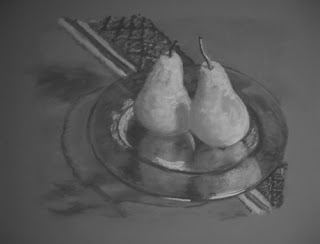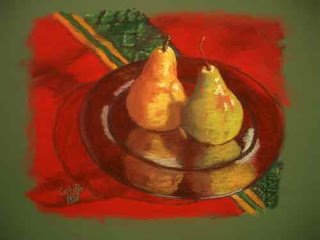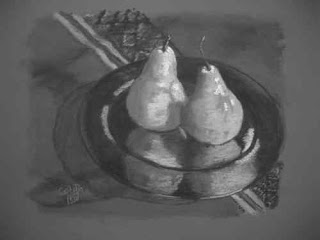In Michael Chesley Johnson's post he started out by discussing painting in pastels with a very limited palette. To do this effectively you need to have knowledge of value and color theory. Michael makes good use of complements and color variation to show depth without a large value change. By color variation, I mean warm and cool tones in the same color. A warm red has orange tones and a cool red has blue tones. The warm colors come toward the viewer and the cool colors recede, giving form to flat shapes. In using only 12 or so pastels, Michael has a small value range to give shape to form (in his painting, it is the landscape). As Michael says in his thread and discussion on wetcanvas.com "But quite often, beginners, in order to distinguish light from shadow, will push the value contrast too much and make the lit areas far too light. A more satisfactory approach is to not push the value contrast, but to push the color temperature contrast instead." (Value is how light or dark a color is. If the value is correct, it is said, you can paint an object any color and it is still the object.) It is a good idea to go read both the blog and comments and the wetcanvas.com thread, you will find it interesting and a learning experience. The discussion is with Micahel and several other pastel artists that teach as well. Questions from emerging artists are thrown into the mix for a lively read.
Maggie Stiefvater has been discussing complements and was nice enough to point to my painting, "Pears on Red". This ties in with Michael's discussion in the temperature of colors. Complements are opposite on the color wheel, red and green for example. These colors seem to vibrate when placed next to each other creating excitement in a painting. Too much can create tension. By blending the two, you gray down the color and you can push it either way. More red, you get gray red and more green you get a gray green. You can make more sense of that if you keep reading.
My tendency in painting has been to use color to describe everything. I hadn't studied much about value and in the past few years I have made progress. After taking workshops and reading the artist blogs and all the learning venues on-line I have begun to add more value/contrast into my work. The idea is too fool the eye into thinking that the flat painting surface has depth, almost like 3-D. I am hoping you can see the difference and that my paintings have more "pop" with the combination of value and color.
A good example is my pastel painting, "Pears on Red".
 In this first photo the painting looks pretty good. The colors give the pears shape. You can definitely tell where the red tablecloth ends and the green paper begins. There is a difference in the yellow and more green pear. The color tones give them shape, the yellow green comes forward on the front of the pears and the more blue green goes back. The grayed shadows recede as well. The complements of red and green add the excitement, dominated by red so that there is not an equal amount of green to fight with the red for attention.
In this first photo the painting looks pretty good. The colors give the pears shape. You can definitely tell where the red tablecloth ends and the green paper begins. There is a difference in the yellow and more green pear. The color tones give them shape, the yellow green comes forward on the front of the pears and the more blue green goes back. The grayed shadows recede as well. The complements of red and green add the excitement, dominated by red so that there is not an equal amount of green to fight with the red for attention. When changed to black and white, value comes into play. You can hardly tell where the green paper meets the red table cloth and of course you cannot tell the color of the pears, they are close in value. The shapes are somewhat lost and look flat.
When changed to black and white, value comes into play. You can hardly tell where the green paper meets the red table cloth and of course you cannot tell the color of the pears, they are close in value. The shapes are somewhat lost and look flat. After studying the black and white photo, I pumped up the value contrast. You can see the difference the pears have a better shape. I didn't add any new colors, just darkened the shadows and cloth and put stronger highlights on the fruit and plate. The highlights on the green pear is actually light red, not white. On the plate the highlights are light green. This is using complements for vibrancy and value, too.
After studying the black and white photo, I pumped up the value contrast. You can see the difference the pears have a better shape. I didn't add any new colors, just darkened the shadows and cloth and put stronger highlights on the fruit and plate. The highlights on the green pear is actually light red, not white. On the plate the highlights are light green. This is using complements for vibrancy and value, too. Checking it out again in black and white you can see where the values added to the shapes.
Checking it out again in black and white you can see where the values added to the shapes.In framing, the green paper doesn't show of course. I hope you like it.
I find that I usually use a limited palette. I take the pastels from their containers and keep them in a tray so I use the same sticks without hunting for them. In my class with Bob Rohm in October I learned that before I start my painting, I take out a dark, medium and light pastel stick in colors I think will work. For example for the trees, 3 greens. As I work I will probably add a cooler or warmer green. In the end, I guess I will usually have around 20 - 30 pastels out. With pastels you can under paint shadows with black to get a darker blue or purple. You can blend in or scumble a little, very little, white to lighten a color. (This takes practice.) When I paint with oils or acrylics I rarely have more than 12 colors out. I rarely use black in liquid paint. I rarely use white or black alone in any medium.
My conclusion in this is that artists must find a happy medium where color and value improve paintings. An artist can also work with a limited palette using color temperature to enhance the shapes and value to add more drama.


17 comments:
Jo, when I get a chance I'll check out these links. This is a great post, lots of interesting stuff here. I'm still working on wrapping my head around the temperature within a color thing - not sure that I act on that instinct yet. All that to say, thanks for the brain food!
Have a good weekend.
I had a nice surprise today when I popped over to Maggie's blog, and saw your pair of pears there.
The piece looks beautiful, doesn't it?!!!
Rose, thank you for checking in. It all takes time and practice. Maybe I'll get it by the time I grow up. :)
Leslie, it was fun to see my pears on Maggie's post. She wrote nice things about me, too. :)
Jo, you deserve to have those nice things said about you, again and again!
And as I often tell my son, growing up is overrated!:-)
Rose, you know the right things to say. :)
What a beautiful painting - it's so original and the colors are great!! I think this has been one of my favorites for quite a while... Can you get some prints made??
such a helpful post...I am anxious to try a few of the ideas here. Thanks!
Jo: Amazing, the changes in the painting are wonderful. I enjoyed the write-up from a non-artist point of view. Very nice post.
Rhonda, thank you. Don't we wish we could see and do all these things without thinking. Once in a while I can zone in and then painting is so easy. :) I hope you post yours.
Fishing guy, thanks for stopping in. I loved the stolen boat story!
Jo - Thanks for explaining how you changed the pear painting...ideas to ponder. The final version is gorgeous! The change in the values really makes it so much better.
Hi Joan, you are most welcome. After this has been framed for over a year, I see that I could have darkened the bottom of the pears even more. This is related to the tomato post in December.
Jo, I really enjoyed this post. Thanks for sharing! I shared it with my art students too.
Valerie, thank you, glad I could help.
Hi Jo, I have been wandering through your posts and really liked this one a lot. Good article, with valuable information and you really showed what a difference slight value changes can make by showing the different examples and gray scales.
Hi Paul, value is always a challenge. Thanks for stopping by.
Post a Comment